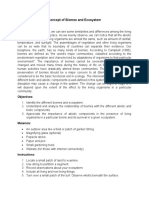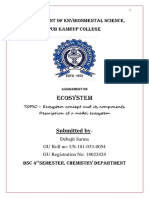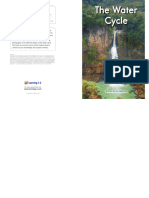0 ratings0% found this document useful (0 votes)
54 viewsUniversity of Eastern Philippines: Uep - Edu.ph Email
The document discusses environmental science topics from a university in the Philippines. It compares and contrasts the terms environment and ecosystem, noting that an environment is everything surrounding us while an ecosystem is a community of interacting living and nonliving components. It also discusses the interdependence of living and nonliving components in an ecosystem, providing examples of how plants, animals, abiotic factors like sunlight, water, and soil interact and affect one another.
Uploaded by
Maria Miguela TanCopyright
© © All Rights Reserved
Available Formats
Download as DOCX, PDF, TXT or read online on Scribd
0 ratings0% found this document useful (0 votes)
54 viewsUniversity of Eastern Philippines: Uep - Edu.ph Email
The document discusses environmental science topics from a university in the Philippines. It compares and contrasts the terms environment and ecosystem, noting that an environment is everything surrounding us while an ecosystem is a community of interacting living and nonliving components. It also discusses the interdependence of living and nonliving components in an ecosystem, providing examples of how plants, animals, abiotic factors like sunlight, water, and soil interact and affect one another.
Uploaded by
Maria Miguela TanCopyright
© © All Rights Reserved
Available Formats
Download as DOCX, PDF, TXT or read online on Scribd
You are on page 1/ 3
Republic of the Philippines
UNIVERSITY OF EASTERN PHILIPPINES
University Town, Northern Samar, Philippines
Website: uep.edu.ph; Email: ueppres06@gmail.com
Module 3.1-3.2 – Environmental Science
Learning Activities:
1. Compare and Contrast the terms Environment and Ecosystem.
The environment is everything that surrounds us, it is the area we live in, in a
given point of time. It enables us to live on earth by sustaining life. It comprises all the
physical, chemical, and natural forces that exist on our planet. The environment is
derived from the word ‘environ’ which means surrounding in French. The biotic
components of the environment are all organisms like birds, animals, human beings,
reptiles, including the microorganisms like bacteria, algae, viruses, and so on. The abiotic
components of the environment are soil, land, mountain, river, cloud, air, including
physical components like temperature, humidity, and so on. The environment is very
crucial for good health and sustenance of life on Earth. However, over the past few years’
human activities, modernization, and industrialization have deteriorated the
environmental conditions. Deforestation, air pollution, acid rain, soil erosion are the
consequences of environmental imbalance that also affect the life of living organisms. It
is very important to look after the environment and take measures to save it and keep it
healthy.
The ecosystem is considered as the structural and functional unit of ecology. It is
a community where the living and nonliving components of the environment are in
continuous interaction. It can be termed as the chain of interactions taking place between
living organisms and the environment. It can be small or huge. I can be an oasis in the
desert or an ocean that covers thousands of miles. It is responsible for maintaining
stability within the environment. An ecosystem is either aquatic, that which exists in the
water or terrestrial, which means the land-based ecosystems. Different land-based
ecosystems are forest, grassland, tundra, and desert. An aquatic ecosystem is either
freshwater or marine. All biotic and abiotic components are interrelated in an ecosystem.
It is always in the state of continuous evolution.
Ma. Miguela Tan
BSIT-2D
Environmental Science
2. Discuss the interdependence of the living and nonliving components of an ecosystem.
The interdependence of the living things is that they grow, change, produce waste,
reproduce, and die. Some examples of living things are organisms such as plants,
animals, fungi, and bacteria. While in Non-living things they’re not grow, need
food, or reproduce. Some examples of important nonliving things in an ecosystem
are sunlight, temperature, water, air, wind, rocks, and soil.
Nonliving components are important parts of any ecosystem. Sunlight is
one of the most important nonliving components. Light from the Sun helps plants
to produce food and oxygen. Sunlight also provides heat that makes life on Earth
possible. Without the Sun’s heat, Earth would be too cold for most living things to
survive. Take a deep breath. Every time you breathe, you take in air. Air is a
mixture of gases, including nitrogen, oxygen, and carbon dioxide. These gases are
nonliving components needed by almost all organisms on Earth. Water is another
important nonliving component. Think about how thirsty you get after you
exercise. Your body is telling you that it needs water—you cannot live without it.
In fact, about 60% of your body is water! Temperature is a nonliving component
that affects living things in an ecosystem. Think about what happens when the
temperature drops in the winter. Animals move to warmer areas or hibernate, trees
lose their leaves and stop growing, and people begin to wear warmer clothing.
Soil is another kind of nonliving component. In a desert, the soil is very sandy and
has little moisture. It can support only certain plants that have adaptations to live
with very little rainfall. In a rain forest, the soil can be poor in nutrients but high
in moisture. It supports large trees, long vines, and many other kinds of plants that
take up nutrients in the soil right away and often grow quickly. Animals compete
with each other for nonliving components such as water. But, animals aren’t the
only organisms that compete for the resources around them! Plants also compete
with each other for nonliving parts of an ecosystem. Suppose a fire destroys a
forest. A short while later, new trees start to grow. At first, many young plants
may grow in the forest. But, some plants such as trees are able to absorb more
water and nutrients and they begin to grow taller. As they grow, they block the
sunlight to smaller plants growing below. The smaller plants cannot produce
enough food to sustain themselves and die off. Forest ecosystems change because
conditions in the forest are constantly changing.
While Living Things components also important parts of the ecosystem. A
forest has plants such as grasses, bushes, and trees. The grasses and bushes
provide food to animals like deer and mice. Trees provide shade from the sunlight
and shelter to other organisms. Birds help spread the seeds of a plant to new areas
of the forest. Earthworms mix and move the soil, which helps circulate nutrients
back to the ecosystem. When organisms die, their bodies become part of the soil
Ma. Miguela Tan
BSIT-2D
Environmental Science
and provide nutrients to plants and other organisms. The living components of the
forest depend on each other for survival. Animals that eat only plants are called
herbivores. Animals that eat only other animals are called carnivores. Predators
are atype of carnivore that catch and eat other animals. The animals they catch
and eat are called prey. Animals that eat both plants and animals are omnivores.
Ma. Miguela Tan
BSIT-2D
Environmental Science
You might also like
- PEOPLE and The Earth's Ecosystem - Third v. Zabala100% (1)PEOPLE and The Earth's Ecosystem - Third v. Zabala30 pages
- Environmental Science Cambil JR Ronald S. Activity FridaNo ratings yetEnvironmental Science Cambil JR Ronald S. Activity Frida4 pages
- Abiotic and Biotic Components Free Essay ExampleNo ratings yetAbiotic and Biotic Components Free Essay Example5 pages
- Lesson 8 - Abiotic Components of An EcosystemNo ratings yetLesson 8 - Abiotic Components of An Ecosystem3 pages
- St Adusco Biology Notes (Ecology 1, Mammalian Anatomy, Ecology 2, Cell 2, Genetics, Evolution, Rep in Mammals & Plants)_061031_062439_082115No ratings yetSt Adusco Biology Notes (Ecology 1, Mammalian Anatomy, Ecology 2, Cell 2, Genetics, Evolution, Rep in Mammals & Plants)_061031_062439_082115356 pages
- Foundations of Terrestrial Ecosystems: The Earth's Web, #1From EverandFoundations of Terrestrial Ecosystems: The Earth's Web, #1No ratings yet
- Environmental Awareness: Giliana Rowence H. Gonido BSED Filipino - L - 1B100% (1)Environmental Awareness: Giliana Rowence H. Gonido BSED Filipino - L - 1B6 pages
- Natural Environment and Modified EnvironmentNo ratings yetNatural Environment and Modified Environment2 pages
- Ecosystem: Department of Environmental Science, Pub Kamrup CollegeNo ratings yetEcosystem: Department of Environmental Science, Pub Kamrup College8 pages
- What Would Happen To Us If We Lost Our ForestNo ratings yetWhat Would Happen To Us If We Lost Our Forest8 pages
- The Environment: Subject Code: GEELECES First Semester, S.Y. 2021-2022 Subject Title: Environmental Science Lesson 1No ratings yetThe Environment: Subject Code: GEELECES First Semester, S.Y. 2021-2022 Subject Title: Environmental Science Lesson 16 pages
- Environmental Laws and Protection Lesson 1No ratings yetEnvironmental Laws and Protection Lesson 120 pages
- The Difference Between A Lake and A RiverNo ratings yetThe Difference Between A Lake and A River2 pages
- Title of The Project Managing Flood Prone AreasNo ratings yetTitle of The Project Managing Flood Prone Areas24 pages
- Kami Export - Roberto Noe Salazar - Physical Geography of North Africa Guided NotesNo ratings yetKami Export - Roberto Noe Salazar - Physical Geography of North Africa Guided Notes2 pages
- Bahan Ajar-Aprilyana Lintawati-Purwanti Widhy Hastuti, S.PD., M.Pd.No ratings yetBahan Ajar-Aprilyana Lintawati-Purwanti Widhy Hastuti, S.PD., M.Pd.84 pages
- Kajian Inflow, Outflow Dan Water Balance Danau Beratan Di Dataran Tinggi Bedugul BaliNo ratings yetKajian Inflow, Outflow Dan Water Balance Danau Beratan Di Dataran Tinggi Bedugul Bali10 pages
- GEO 200 Milestone Two Speaker Notes Student ExampleNo ratings yetGEO 200 Milestone Two Speaker Notes Student Example18 pages
- 1 Describe The Distribution of Active Volcanoes, Earthquake Epicenters and Major Mountain BeltsNo ratings yet1 Describe The Distribution of Active Volcanoes, Earthquake Epicenters and Major Mountain Belts3 pages
- ArDesign 3 Module 2 - Site Analysis - Week 7No ratings yetArDesign 3 Module 2 - Site Analysis - Week 727 pages
- Review Questions For Tamkeen Final Exam Grade 5 Term 3 21june 2024No ratings yetReview Questions For Tamkeen Final Exam Grade 5 Term 3 21june 202414 pages
- GEOG 2212: World Geography: Day02: 08/21/09 FridayNo ratings yetGEOG 2212: World Geography: Day02: 08/21/09 Friday14 pages
- Estuaries Classific Ation:: Geograph Ic Origin & Water MixingNo ratings yetEstuaries Classific Ation:: Geograph Ic Origin & Water Mixing13 pages
- Interlinking Rivers of India Is It NecessaryNo ratings yetInterlinking Rivers of India Is It Necessary13 pages
- GE 1001 Foundations of Geography The Atmosphere and Hydrosphere of The EarthNo ratings yetGE 1001 Foundations of Geography The Atmosphere and Hydrosphere of The Earth6 pages
- Clastic Sedimentology and Petrography - Deltas - QAB2023No ratings yetClastic Sedimentology and Petrography - Deltas - QAB202334 pages

























































































